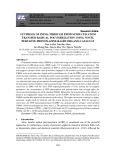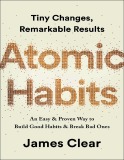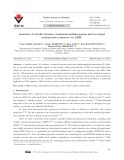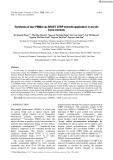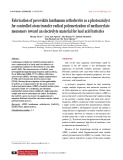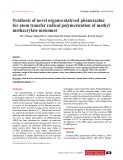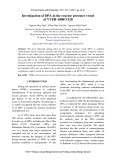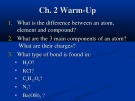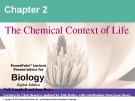
The atomic weight
-
The study aims to demonstrate the capability of PHP in synthesizing PMMA via photo-induced ATRP and suggests a proper molar ratio of reactants engaged in the synthesis process to obtain outcome PMMA in terms of molecular weight and low polydispersity.
 14p
14p  vimichaelfaraday
vimichaelfaraday
 28-12-2023
28-12-2023
 5
5
 3
3
 Download
Download
-
Ebook "Atomic habits: An easy & proven way to build good habits & break bad ones" will reshape the way you think about progress and success, and give you the tools and strategies you need to transform your habits--whether you are a team looking to win a championship, an organization hoping to redefine an industry, or simply an individual who wishes to quit smoking, lose weight, reduce stress, or achieve any other goal.
 290p
290p  phuong10693
phuong10693
 20-06-2023
20-06-2023
 12
12
 2
2
 Download
Download
-
Quantitative structure–activity relationship (QSAR) analysis of 28 quinoline-arylamidine (CQArA) hybrids against two leukemia cells, K562 and Raji, was performed. Multiple linear regression (MLR) models were obtained by genetic algorithm. The best models involved the following descriptors: radial distribution function (RDF) descriptors, GETAWAY (GEometry, Topology, and Atom-Weights AssemblY) descriptor, bond information content index, and dipole moment. The best MLR models for K562 and Raji cells demonstrated satisfactory stability in internal and external validation.
 16p
16p  tudichquannguyet
tudichquannguyet
 29-11-2021
29-11-2021
 7
7
 1
1
 Download
Download
-
A phthalocyanine (Pc) initiator, tetrakis(2-bromopropyloxyester)ethylthiophthalocyaninatozinc(II) (ZnPcBr), was prepared and successfully applied to atom transfer radical polymerization (ATRP) of methyl methacrylate (MMA) for the first time. Bromine end groups of the synthesized Pc took part in the initiation of the MMA chain growth. Polymerization was demonstrated by monomodal molecular weight distribution of the synthesized polymers and their increasing molecular weight behavior with reaction time.
 15p
15p  tudichquannguyet
tudichquannguyet
 29-11-2021
29-11-2021
 9
9
 1
1
 Download
Download
-
Lecture General Chemistry 1 - Chapter 2: Atoms, Molecules, and Ions. After studying this section will help you understand: learn the basic postulates of Dalton’s atomic theory; describe the key experiments that led to the discovery of electrons and the nuclear model of the atom; tdentify the locations of metals and nonmetals in the periodic table,...
 24p
24p  diepchilang
diepchilang
 26-08-2021
26-08-2021
 7
7
 1
1
 Download
Download
-
In this study, we attempted to apply a four-arm star poly(methyl methacrylate) (4sPMMA) as a prepolymer of acrylic bone cement. The 4sPMMA with viscosity average molecular weight of about 45 kDa was synthesized via Atom Transfer Radical Polymerization method using Activators Regenerated by Electron Transfer (ARGET ATRP). In practical use, the fine powder of precipitated 4sPMMA was changed to rigid beads followed by making sheet and pulverizing.
 6p
6p  nguaconbaynhay11
nguaconbaynhay11
 16-04-2021
16-04-2021
 10
10
 2
2
 Download
Download
-
Lanthanum orthoferrite (LaFeO3 ) photocatalysts were synthesized by a facile and cost-effective coprecipitation method via the hydrolysis of La (III) and Fe (III). The characteristics of LaFeO3 were investigated through thermogravimetric analysis (TGA), X-ray diffraction (XRD), UV-Vis diffuse reflectance spectroscopy (DRS), vibrating sample magnetometry (VSM), and transmission electron microscopy (TEM).
 7p
7p  kethamoi7
kethamoi7
 15-08-2020
15-08-2020
 16
16
 2
2
 Download
Download
-
Heavy metal is a general technical term that applies to the group of metals and metalloids with density greater than 4±1 g cm-3 or elements having atomic weight more than 20. Heavy metals are considered toxic to living organisms and even trace metals that are considered essential for life can be toxic when present at excessive level, impair important biochemical process and also pose threat to human health, plant growth and animal life. The heavy metals, As, Cd, Cr, Ni and Pb were found accumulated in seeds collected from various sites.
 7p
7p  trinhthamhodang1213
trinhthamhodang1213
 02-06-2020
02-06-2020
 16
16
 0
0
 Download
Download
-
In this research, a novel organic photocatalyst of 10-(perylene-3-yl-10H-phenoxazine (PHP) has been successfully synthesized from perylene and phenoxazine via Buchwald-Hartwig C-N coupling. The chemical structure of catalyst was determined via FT-IR, proton nuclear magnetic resonance (1 H-NMR) spectrum and optical properties were investigated through UV-Vis spectroscopy. The PHP has been used as the reducing photoredox catalyst for organocatalyzed atom transfer radical polymerrization (O-ATRP) under UV irradiation.
 5p
5p  12120609
12120609
 02-04-2020
02-04-2020
 37
37
 3
3
 Download
Download
-
A quantitative structure–activity relationship (QSAR) study was carried out on 112 anticancer compounds to develop a robust model for the prediction of anti-leukemia activity (pGI50) against MOLT-4 and P388 leukemia cell lines. The Genetic algorithm (GA) and multiple linear regression analysis (MLRA) were used to select the descriptors and to generate the correlation models that relate the structural features to the biological activities. The final equations consist of 15 and 10 molecular descriptors calculated using the paDEL molecular descriptor software.
 15p
15p  kequaidan1
kequaidan1
 16-11-2019
16-11-2019
 13
13
 1
1
 Download
Download
-
The most important ageing effect on the reactor pressure vessel (RPV) is radiation embrittlement, which is mainly caused by fast neutrons during operation lifetime of nuclear reactors. The aim of this study was to investigate the DPA (displacement per atom) rate, an important parameter describing radiation damage to the RPV, and identify the position of the maximum DPA rate in the RPV of the VVER-1000/V320 reactor using the Monte Carlo code MCNP5.
 10p
10p  vineptune2711
vineptune2711
 04-11-2019
04-11-2019
 10
10
 0
0
 Download
Download
-
Identify the four major elements; distinguish between the following pairs of terms: neutron and proton, atomic number and mass number, atomic weight and mass number; distinguish between and discuss the biological importance of the following: nonpolar covalent bonds, polar covalent bonds, ionic bonds, hydrogen bonds, and van der Waals interactions.
 19p
19p  nomoney10
nomoney10
 04-05-2017
04-05-2017
 45
45
 4
4
 Download
Download
-
Chapter 2 - The chemical context of life. In this chapter, you should now be able to: Identify the four major elements; distinguish between the following pairs of terms: neutron and proton, atomic number and mass number, atomic weight and mass number; distinguish between and discuss the biological importance of the following: nonpolar covalent bonds, polar covalent bonds, ionic bonds, hydrogen bonds, and van der Waals interactions.
 50p
50p  tangtuy02
tangtuy02
 08-03-2016
08-03-2016
 45
45
 2
2
 Download
Download
-
The PML Grant Program provides financial assistance consistent with the PML mission to support research in the broad areas of mechanical metrology, semiconductors, ionizing radiation physics, medical physics, biophysics, neutron physics, atomic physics, optical technology, optoelectronics, electromagnetics, time and frequency, quantum physics, weights and measures, quantum electrical metrology, temperature, pressure, flow, far UV physics, and metrology with synchrotron radiation.
 35p
35p  thamgiacongdong
thamgiacongdong
 02-05-2013
02-05-2013
 34
34
 6
6
 Download
Download
-
Prediction and understanding of the folding and stability of the 3D struc-ture of proteins is still a challenge. The different atomic interactions, such as non polar contacts and hydrogen bonding, are known but their exact relative weights and roles when contributing to protein folding and stability are not identified.
 17p
17p  cosis54
cosis54
 08-12-2012
08-12-2012
 42
42
 2
2
 Download
Download
-
As of June 2002, astronomers had discovered more than 100 other planets orbiting distant suns. With advances in tech- nology, that number will surely increase during the opening decades of the twenty-first century. Although our explorations of the Cosmos hold great promise of future discoveries, among all of the known worlds, Earth remains unique. Thus far it is the only known planet with blue skies, warm seas, and life.
 387p
387p  banhkem0908
banhkem0908
 24-11-2012
24-11-2012
 67
67
 3
3
 Download
Download
-
Tài liệu tham khảo giáo trình nhôm trong thiết kế xây dựng - Chương 1 About aluminium 1.1 GENERAL DESCRIPTION 1.1.1 The element Aluminium is a metallic element having the chemical symbol Al, with atomic number 13 and atomic weight 27. The nucleus of the atom contains 13 protons and 14 neutrons (a total of 81 quarks). Aluminium is the third most common element in the earth’s crust, coming after oxygen and silicon. It makes up 8% of the crust’s total mass and is the most abundant metal....
 39p
39p  vitconmengu
vitconmengu
 14-08-2011
14-08-2011
 90
90
 18
18
 Download
Download
-
Aluminum is the most abundant metallic element, making up about 8% by weight of the Earth’s crust. It is a silverywhite metal and belongs to group III of the periodic table. Its atomic number is 13 and atomic weight 26.981 54. Pure aluminum is soft and ductile.
 0p
0p  congdat261
congdat261
 01-12-2010
01-12-2010
 105
105
 10
10
 Download
Download
-
Nitrogen Rule: If the nominal molecular weight of an analyte appears to be an even mass number, the compound contains an even number of nitrogen atoms (or no nitrogen atoms). On the other hand, if the nominal molecular weight of an analyte appears to be an odd mass number, the com- pound contains an odd number of nitrogen atoms.
 37p
37p  bigbaby87
bigbaby87
 03-09-2010
03-09-2010
 72
72
 15
15
 Download
Download
CHỦ ĐỀ BẠN MUỐN TÌM








